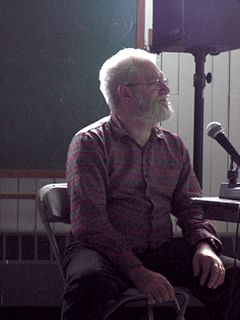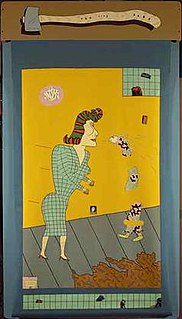
Bruce Nauman is an American artist. His practice spans a broad range of media including sculpture, photography, neon, video, drawing, printmaking, and performance. Nauman lives near Galisteo, New Mexico.

Daniel "Dan" Graham is an American artist, writer, and curator.

Melvin John Ramos was an American figurative painter, specializing most often in paintings of female nudes, whose work incorporates elements of realist and abstract art.

The Crocker Art Museum, formerly the E. B. Crocker Art Gallery is the longest continuously-operating art museum in the West. Located in Sacramento, California, the Museum hosts one of the state's premier collections of Californian art. The collection contains works dating from the Gold Rush to the present day, a collection of master drawings, European paintings, one of the largest international ceramics collections in the U.S. and collections of Asian, African, and Oceanic art.

Leo Castelli was an Italian-American art dealer. His gallery showcased contemporary art for five decades. Among the movements which Castelli showed were Surrealism, Abstract Expressionism, Neo-Dada, Pop Art, Op Art, Color field painting, Hard-edge painting, Lyrical Abstraction, Minimal Art, Conceptual Art, and Neo-expressionism.
Lawrence Gilbert "Larry" Gagosian is an American art dealer who owns the Gagosian Gallery chain of art galleries. Working in concert with collectors including Douglas S. Cramer, Eli Broad and Keith Barish he developed a reputation for staging museum quality exhibitions.

Marcia Tucker was an American art historian, art critic and curator. In 1977 she founded the New Museum of Contemporary Art, a museum dedicated to innovative art and artistic practice in New York City, which she ran as the director until 1999.

Jules Tavernier was a French painter, illustrator, and an important member of Hawaii’s Volcano School.

Robert Brady (1946–present) is an American modernist sculptor who works in ceramics and wood. Born in Reno, Nevada, he has made his home in the San Francisco Bay Area for many decades now. Brady is a multi-faceted artist who additionally works in pottery, painting, and illustration, though he is best known for his abstract figurative sculptures. Brady came out of the California Clay movement, and the Bay Area Arts scene of the 1950s and 60's, which includes artists such as Peter Voulkos, Viola Frey, Stephen de Staebler, and Robert Arneson, who was his mentor and teacher in college.

Funk art is an American art movement that was a reaction against the nonobjectivity of abstract expressionism. An anti-establishment movement, Funk art brought figuration back as subject matter in painting again rather than limiting itself to the non-figurative, abstract forms that abstract expressionists such as Jackson Pollock and Mark Rothko were depicting. The movement’s name was derived from the jazz musical term "funky", describing the passionate, sensuous, and quirky. During the 1920s, jazz was thought of as very basic, unsophisticated music, and many people believed Funk was an unrefined style of art as well. The term funk also had negative connotations because the word had an association with a foul odor. Throughout the 1960s and 1970s, Funk was a popular art form, mainly in California's Bay Area in the United States. Although discussed as a cohesive movement, Funk artists did not feel as if they belonged to a collective art style or group. This is because while its artists shared the same attitudes and created similar works, they were not necessarily working together.

William T. Wiley is an American artist. His practice spans a broad range of media including drawing, painting, sculpture, film, performance, and pinball. At least some of Wiley's work has been referred to as funk art.
Ernest Briggs (1923–1984) was a second-generation Abstract Expressionist painter known for his expressive, sometimes calligraphic brushwork, his geometric compositions, and revolution in abstract painting that secured New York City's position as the art capital of the world in the post-World War II period.
Giuseppe Panza di Biumo was a collector of modern art. He lived in Milan and Varese, Italy.
David Bradshaw is an American artist based out of Cecilia, LA and E. Charleston, Vermont. He is a painter, sculptor, and printmaker.
Roland Petersen is an American painter and printmaker of Danish birth. Petersen was born 1926 in Endelave, Denmark. His career spans over 50 years primarily in the San Francisco Bay Area and is perhaps best-known for his Picnic series beginning in the 1960s to today. These paintings made their debut in New York at the Staempfli Gallery.
Paul Kos is a conceptual artist and one of the founders of the Bay Area Conceptual Art movement in California. Paul Kos was one of the first artists to incorporate video, sound and interactivity into his sculptural installations.
Dawn Clements (1958–2018) was an American contemporary artist and educator. She was known for her large scale, panoramic drawings of interiors that were created with many different materials in a collage-style. Her primary mediums were sumi ink and ballpoint pen on small to large scale paper panels. In order to complete a drawing she cuts and pastes paper to edit things and achieve the desired scale. Her completed drawings show her process of editing and adding through wrinkles and folds.
Jill Giegerich is an American visual artist known for her paintings and photography. She has had over twenty solo exhibitions, including those at the Santa Monica Museum of Art, Los Angeles Institute of Contemporary Art, San Francisco Museum of Art among others. Her work has been presented in over 100 group exhibitions, including those at the California Museum of Photography, Orlando Museum of Art, Museum of Contemporary Art, Los Angeles, Los Angeles County Museum of Art, Sezon Museum of Modern Art, Tokyo, Japan, among others. A retrospective survey of her art from 1979-2001 was held at the Armory Center for the Arts in Pasadena, California.

Rudolf "Rudi" Hess was an American fine art painter, sculptor and art critic, based in Northern California. His work is of the German Expressionist school and the subject matter covers many genres including landscapes and nature, portraits and everyday city life.

Frank Owen is an American abstract painter based in Keene, New York.



















